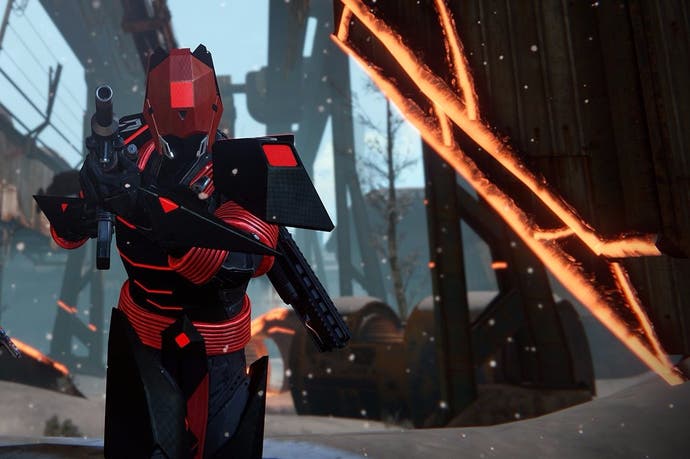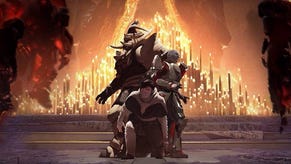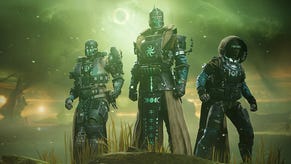Destiny: Rise of Iron review
Test your metal.
Rise of Iron pushed me past the 500 hour mark in Destiny, but I'd have gotten there regardless.
I've been playing a lot again, spurred back by this summer's Moments of Triumph checklist. Destiny is still, for my Glimmer, the best-handling console shooter in the business. It is an incredible game to play with friends. At its best, Destiny has provided some of my most cherished gaming moments of the past two years, from clutched victories over bullet sponge bosses and selfless teamwork in the game's demanding raids, to the incredible collaboration of its community, where strategies are discovered and passed on via word of mouth as players try to get an edge on Bungie's opaque systems.
Destiny can be a fantastic experience, but it often is so despite Bungie's own intentions. There's another side to Destiny, where its repetitive tasks can be frustrating, time-consuming and unrewarding. It can feel downright unfair. Rise of Iron doesn't improve this status quo one bit.
Destiny players love to complain about the game. Any sniff of Bungie offering emotes for premium versions of the game, holding back exclusives for one set of consoles, creating a slightly shorter and more manageable raid - players care. The rebalancing or removal of a single exotic weapon, a gun which may have required tens of hours or months of luck to obtain, can produce uproar. And then there's the things Bungie keeps better hidden - its loot drop rates or the number of hours it expects players to put in before receiving reward.
Last year's The Taken King - which remains the high watermark for Destiny expansions - completely restructured progression. It introduced a gear infusion system which streamlined how you used loot and smoothed Light levels into a manageable curve. This year's April update tweaked these settings further and made the experience better still. The effect both sets of changes had on the game was instant. Because - while Destiny's gunplay shines moment-to-moment, and while you are completing a strike and defeating a boss or watching the clock and trying to take down every last enemy, jumping and sliding and shotgunning and meleeing - you're doing all of it for loot.
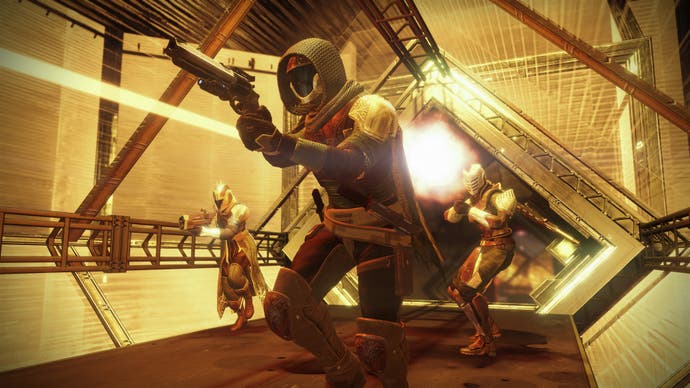
The endgame is always loot. Destiny is a numbers game in a sci-fi setting, where yes, you can defeat towering time-travelling mechanoids and a winged demigod who's pissed you killed his son, but the endgame is about numbers. It's about how this experience stacks up the second time you're asked to play through the same missions. And the third, and the fourth.
Rise of Iron's loot system feels like too much of a grind. There's a mountain of new Light levels to climb, but instead of a manageable curve there are numerous choke points along the way. You'll start at around 335 - that's the old level cap, since April's update last moved the goalposts. 340 is simple - blue/rare engrams will take you there in no time. Levels 340-350? You'll have to find rare weapons via straight loot drops, rather than those which you decrypt. Purple/legendary engrams? Well, they've inexplicably changed. They may decrypt higher than your Light to give you a small boost towards the next level, but they're just as likely to hold you there. 365? Now you're talking a couple of dozen hours in the game's Strike playlist - those same strikes - for end of mission rewards which will inch you up. Oh, but your Light-giving Ghost and Artefact are holding you back? You may need a new Skeleton Key item to improve your chances of those. Higher? Keep doing those Strikes, you'll be raid ready. And then by raiding and more Strikes, and more Strikes, you're 385 - more or less the top level. Until the hard mode raid releases in a few weeks and moves the goalposts once more, up to Light level 400.
Destiny has always been about the loot grind: your ever-spinning wheels of gear strength, faction reputation and bounty XP. When it comes to your all-important overall Light level, however, Rise of Iron constantly feels like it is squeezing on the brakes. (Bungie's removal of a long-known exploit to drastically speed up the acquisition of Strike loot was eye-opening, both for the way the method's popularity spiked among Destiny's community in response to the grind and for how swiftly it was spiked by Bungie to stop players using it.) Rise of Iron has to last players until Destiny 2 - still a year away, but a project that has occupied the vast majority of Bungie since the beginning of this year. It shows. Whether because of its smaller amount of content than Taken King or the longer wait until more arrives in Destiny 2, or both, Rise of Iron feels designed to stretch out player time.
That's not necessarily a bad thing, of course. After so long, the fact so many people are still playing and looking for new things to do speaks to Destiny's moment-to-moment gunplay and the game's overall sticking power. But I remember being focused on so much more than levelling after The Taken King launched last year. I didn't bounce so quickly off the campaign. The Dreadnought's innards held secrets it took me months to fully uncover. The Plaguelands is just an extension to the existing Cosmodrome location on Earth, kitbashed together under a blanket of snow. Its one notable activity is another Court of Oryx-style public event location which has inexplicably become more difficult to join. Not since I had to loop through Vault of Glass back in Year One do I remember Destiny ever being so grind-focused, in fact.

Finish the Rise of Iron story and you're pushed into a couple of weekly questlines to revisit the Plaguelands and complete patrol quests, which is how you collect all the game-modifying Iron Lord artefacts. If you have just the one character this process will last you six weeks. Some of these modifiers are fun (meleeing a Dreg so hard it joins your fireteam remains an amusing sight) but none have seemed to actually shake up the game's meta. There is the expansion's Record Book of stats to fill for a set of flaming armour. Beyond that, well, you'll have to play for quite a while longer to collect all the gun skins ("exotic ornaments") without paying for one of the new Radiant Treasure blind boxes.
Rise of Iron was always described as a slimmer experience than The Taken King and is priced lower, so the meagre number of campaign missions, for example, or the fact there's just one new Strike doesn't come as a total surprise. But when it comes to what's on offer within those, it is noticeable how much its story also feels like a regression to Year One. Rise of Iron does nothing to help Destiny's continued identity crisis: it actually takes a step back from the progress made in Taken King regarding the game's overall tone, story and personality. Gone are the Firefly-esque feelings of character, or the genuine sense of threat felt when going up against a long-teased Big Bad, all replaced by a stuffy dialogue full of sci-fisms and jarring, jokey references to Game of Thrones.
Rise of Iron's main quest givers - Lord Saladin, AKA the guy who previously stood in front of a flaming gong for the game's monthly Iron Banner multiplayer events, and Shiro-6, who I am struggling to think of one standout thing to say about - are cut-price versions of last year's Zavala and Cayde. The over-starched dialogue falls flat, and the mythology it attempts to retcon into Destiny's already patchwork plot can't hide its last-minute invention in the wake of Destiny 2's delay into next year. Rise of Iron's main threat, a technological plague named SIVA, is never explained. (Why is it even called SIVA? The game never stops to say.)
The mostly-extinct Iron Lords are an intriguing element of Destiny's in-game history, although Rise of Iron's brief missions never properly flesh out who they were or why players should care about their demise. The campaign, in tl;dr form, reveals they died fighting off SIVA which you then also sort of defeat but also leave lots of lying around. SIVA is also the conceit for yet another reworking of the base game's enemies, although unlike last year's Taken the new Splicer variants are made up of just one Destiny race, the Fallen, and are mechanically less inventive, too.
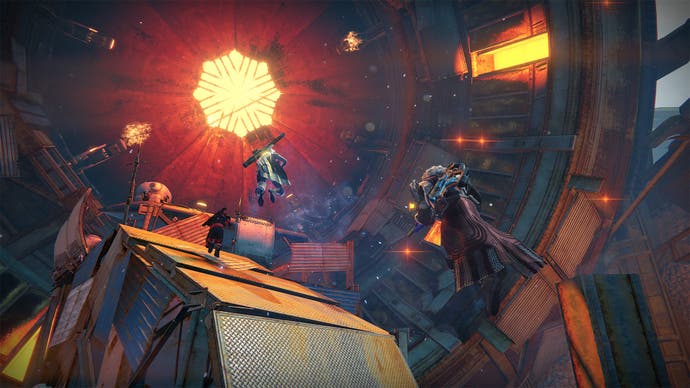
Just as in the base Destiny game, though, there are standout moments. Rise of Iron's introduction, a perilous climb up the snow-capped Felwinter Peak, is miles better than Taken King's Phobos opener. The increased scale on offer here - finally possible, perhaps, due to the long overdue ditching of PS3 and Xbox 360 memory limits - is a welcome addition, and the view from the top sits with any of Bungie's other famous skyboxes. The campaign's closer is just as thrilling as it lets you perform the inverse: a careering descent into an underground space that demands you stop and stare. But these two missions bookend a brief and forgettable filling, with just a couple of quick quest steps in the Plaguelands and an even briefer visit to some of Mars' Dust Palace Strike (which you run through backwards to find a single new room).
Likewise, the new raid is a mixed bag. Wrath of the Machine is a three-act adventure set inside, atop and below the Cosmodrome wall interspersed with the now-standard jumping puzzles. Its first and last sections are familiar Destiny raid encounters, with mechanics to be learned in order to take down a boss' shields and make them vulnerable, and a process which divides up your six-player raid group into smaller teams who then must execute various tasks repeatedly. The middle third of the raid is something else, though - a genuinely inventive set-piece which takes the Splicers' Mad Max-style scavenger aesthetic and revs it up to somewhere very, very cool. Rise of Iron's excellent musical score shines here in particular. Across the expansion, battles with Splicers are given a heavy metal soundtrack unlike anything else in Destiny so far that brilliantly reworks returning cues (as in the remixed Sepiks Strike), while areas tied to the fallen Iron Lords are accompanied by haunting choral pieces, such as the themes heard around Felwinter Peak.
There's a heavy element of nostalgia to Rise of Iron - both in terms of its story, which rekindles the memory of lost heroes from Destiny's in-game history, but far more effectively in how it speaks to Destiny players' own personal history with the game. There's a genuine thrill to revisiting the original Sepiks Strike and seeing him reformed, hearing his theme again with its new Splicer rock overtones. And out of the too-few questlines which do pop up after the campaign concludes, the only two worth mentioning celebrate and reward players with items of particular note to Destiny's community. The first is for Gjallarhorn, the weapon which player word of mouth (and OP stats) forged into the game's most iconic weapon. The second questline is for an exotic version of the Khvostov - the first weapon players ever use in the game's opening level - which includes a reward for those who have kept it safe ever since. I completed both of these with a smile on my face not because of some stiff dialogue or half-explained lore but because of what they reminded me of - those moments spent playing Destiny over the past two years.
Rise of Iron is a strangely appropriate swansong for Destiny's past few years. It's a re-dressed stage for more moments with friends, but also a slog through more of what has made Destiny feel so frustrating - some of which the main team at Bungie, rather than the smaller crew which made this, had already moved past. Rise of Iron is not Destiny's Golden Age, but I haven't lost hope I'll forge more memories yet.
